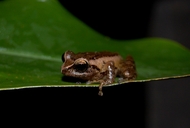|
Pseudophilautus steineri (Meegaskumbura & Manamendra-Arachchi, 2005)
| family: Rhacophoridae subfamily: Rhacophorinae genus: Pseudophilautus |
| Species Description: Meegaskumbura M & Manamendra-Arachchi K 2005 Description of eight new species of shrub frogs (Ranidae: Rhacophorinae: Philautus) from Sri Lanka. Raffles Bull Zool Suppl 12:305-338. | |
 © 2011 Milivoje Krvavac (1 of 6) |
|
|
|
Description Colour in life: Mid-dorsum brown; dorso-lateral area light green; upper flank green with black patches, lower flank ashy green. A dark brownish-black stripe present on upper flank. Interorbital bar dark brown. Posterior head and mid-back brownish-green. Loreal and tympanic regions and tympanum dark brown with light-green stripes. Upper edge of supratympanic fold and canthal edges light brown; lower lip white with brown bands. Chin, chest, abdomen and limbs ventrally pale brown with dark-brown patches. Limbs dorsally brown with dark-brown crossbars. Digits pale-ashy brown. Posterior thigh green (Meegaskumbura & Manamendra-Arachchi, 2005). Colour in alcohol: Mid-dorsum dark brown; flank and inguinal zone ashy brown. Loreal region tympanic region and tympanum dark brown. Limbs dorsally brown or ashy brown; posterior thigh pale brown. Venter and webbing yellowish brown. (Meegaskumbura & Manamendra-Arachchi, 2005). Distribution and Habitat Country distribution from AmphibiaWeb's database: Sri Lanka
Life History, Abundance, Activity, and Special Behaviors All frogs of this genus are terrestrial direct developers (Bahir et al. 2005). Possible reasons for amphibian decline General habitat alteration and loss Comments
References
Bahir, M. M., Meegaskumbura, M., Manamendra-Arachchi, K., Schneider, C. J., and Pethiyagoda, R. (2005). ''Reproduction and terrestrial direct development in Sri Lankan shrub frogs (Ranidae: Rhacophorinae: Philautus).'' The Raffles Bulletin of Zoology, 12, 339-350. [link] Batuwita S, Udugampala S, DeSilva M, Diao J and Edirisinghe U. (2019). "A review of amphibian fauna of Sri Lanka: distribution, recent taxonomic changes and conservation." Journal of Animal Diversity, 1(2), 44-82. [link] Meegaskumbura M. & Manamendra-Arachchi K. (2005). ''Description of eight new species of shrub frogs (Ranidae: Rhacophorinae: Philautus) from Sri Lanka.'' Raffles Bulletin Zoology Supplemental, 12, 305-338. [link] Originally submitted by: Dayupathi Eranda Nipunika Mandawala (2021-07-31) Description by: Dayupathi Eranda Nipunika Mandawala (updated 2021-07-31)
Distribution by: Dayupathi Eranda Nipunika Mandawala (updated 2021-07-31)
Life history by: Dayupathi Eranda Nipunika Mandawala (updated 2021-07-31)
Comments by: Dayupathi Eranda Nipunika Mandawala (updated 2021-07-31)
Edited by: Michelle S. Koo (2021-07-31) Species Account Citation: AmphibiaWeb 2021 Pseudophilautus steineri <https://amphibiaweb.org/species/6518> University of California, Berkeley, CA, USA. Accessed Jun 1, 2025.
Feedback or comments about this page.
Citation: AmphibiaWeb. 2025. <https://amphibiaweb.org> University of California, Berkeley, CA, USA. Accessed 1 Jun 2025. AmphibiaWeb's policy on data use. |



 Map of Life
Map of Life